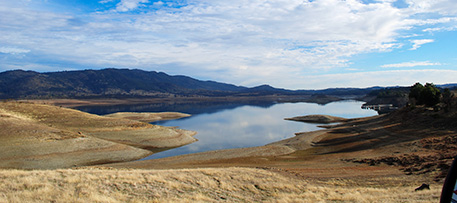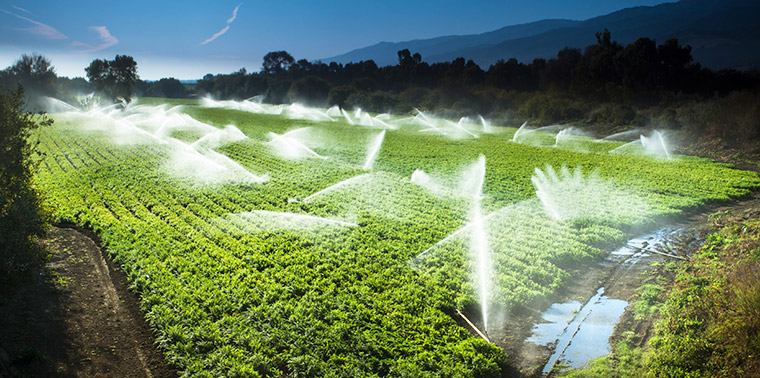August 28, 2014 — Grapevines march across wires strung along rolling hills, their little trunks improbably supporting heavy black fruit. Cindy Steinbeck’s family has been farming this land since 1920. They grow Zinfandel, Viognier, Cabernet, Merlot, and Petite Syrah grapes but are best known in this area of Central California for a blend called The Crash, named after a remarkable incident in 1956, when a B-26 crash-landed 200 yards from the family home. Four of the five Air Force men aboard survived, bailing out in the nearby fields.
Now a new crash threatens, as groundwater levels beneath the vineyards plummet. California produces nearly half of U.S.-grown fruits, nuts and vegetables, according to the state’s Department of Food and Agriculture. It is in the midst of one of the worst droughts ever recorded, with more than 80 percent of the state in extreme or exceptional drought. But so far, the Steinbeck Vineyards’ 520 acres of grapes are growing well under the hot August sun, thanks to the family’s access to all the groundwater they need: up to 2 acre-feet per acre per season. (An acre-foot is the amount of water required to flood an acre of land one foot deep — about 326,000 gallons.) The Steinbecks’ sole source of irrigation is groundwater.
However, groundwater and surface water — rivers, lakes, streams — are part of the same hydrological system. Excessive groundwater pumping can overdraft aquifers, emptying them faster than natural systems can replenish them; dry up nearby wells; allow saltwater intrusion; and draw down surface water supplies. Taking so much water out of the soil can cause the dirt to compact and the land to sink, an action called subsidence. Because land can subside as much as a foot a year in the face of aggressive pumping, it can destroy infrastructure such as irrigation canals, building foundations, roads, bridges and pipelines.

Dry weather has led to significantly lower water levels than usual in many lakes such as New Hogan Lake in Valley Springs, Calif. (U.S. Army photo by Kaitlin Blagg/Released)
The Steinbecks have been able to tap this subterranean resource at will because they own the land above it — and because California is the only western state that lacks groundwater regulation. But that boon to farmers is also a looming disaster, as groundwater levels free fall. Groundwater is a huge piece of California’s water supply, making up approximately 40 percent of the state’s water demands in an average year and up to 60 percent or more during droughts, according to the Department of Water Resources.
“In the absence of governance, it’s become a pumping arms race,” says Felicia Marcus, chair of the State Water Resources Control Board. “He with the biggest pump or deepest straw wins.”
But now a bill on the floor of the California legislature could turn that around. Although water rights holders in California have been resistant to change, this week the state is considering one big step forward: senate bill 1168 and assembly bill 1739, which would provide statewide groundwater regulation for the first time. These bills “embrace the concept that groundwater is best managed locally,” said senate bill author Sen. Fran Pavley, D-Agoura Hills, as she brought the vote on the assembly bill August 27. “Manage your groundwater basins, and the state will not have any reason to interfere with your right to have your own governance board and to set your own rules and regulations,” she said.
The assembly bill passed the senate and will now return to the assembly for a final “concurrence” vote. The senate bill must still pass the assembly and, once again, the senate, before the session ends Aug. 31. Then Gov. Jerry Brown will have 30 days to sign or veto it. He has been supporting the bill throughout the process.
However, even if the bill becomes law, it’s unclear whether it will help the folks in Paso Robles avoid the current spate of neighbors suing neighbors. Groundwater basins would have two years to form a local management agency, five years to adopt a sustainable management plan, and 20 years to achieve a sustainable supply of groundwater.
The Paso Robles groundwater basin has been declining for years, says San Luis Obispo County board of supervisors chair Bruce Gibson, but “the drought has magnified the effect.” When wells began to dry up last summer, the board passed a moratorium on new water use in the basin that prohibits both new buildings outside of city limits and planting new crops without fallowing others.
Historically, landowners in California have considered water beneath their land to be part of their property rights.
That’s how Steinbeck and her neighbors see it. Any limitation to their right to pump and use the water under their land, such as the moratorium, is “taking over our rights,” says Steinbeck.
Gibson says the county is “exercising its land use authority. Property rights are not absolute: One can do a range of activities on their property as long as it doesn’t infringe on others’ similar enjoyment of their property.”
Suing has become standard practice in California when groundwater basins are overdrafted because the state lacks regulation and pumping is largely unmeasured.
The landowners filed suit last fall against San Luis Obispo County and four municipal water companies. This summer, this and a related lawsuit have recently been transferred to San Jose, a city to the north, because everyone agrees that no one local can be impartial.
Suing has become standard practice in California when groundwater basins are overdrafted because the state lacks regulation and pumping is largely unmeasured. In these cases, a court decides who may extract how much and who will manage the basin to ensure everyone is using water according to the court’s decree, a process called adjudication.
There are currently 22 adjudicated groundwater basins in California, according to the California Department of Water Resources. Adjudication can be time-consuming and expensive for all concerned. In San Luis Obispo County, the Santa Maria Groundwater Basin adjudication “is now going on its 12th year and is still in court appeals. Total costs for all parties are over $11 million,” says the San Luis Obispo County website, and could go significantly higher.
Groundwater Managed?
The property rights narrative for groundwater rights “is called into question if your neighbor pumps out so much water that your well runs dry,” says California Assemblymember Roger Dickinson, D-Sacramento, author of the assembly bill. When this happens, farmers begin to recognize that if they don’t act collectively, their personal property rights could become “hollow and without much meaning,” he says.
Groundwater legal reform was on table 40 years ago, during Gov. Brown’s first tenure. But the current drought has heightened water anxiety to the point where the current groundwater free-for-all might be brought under a legal framework at last. If successful, the law could help avoid future conflicts.
“We should never let a good crisis go to waste,” says Dickinson.
California has lagged other states in this area because a strong political lobby of groundwater users resisted state regulation – and many still do, says Brian Gray, a law professor at University of California Hastings College of the Law who has argued water resources cases before the California Supreme Court. But now, both the Association of California Water Agencies, a water utilities trade group, and the California Water Foundation, a nonprofit focused on balancing California’s water needs, support the new bill.
Lester Snow, executive director of the California Water Foundation, says, “The basic model is that we empower local agencies, give them tools and authority, and then set up the state as a backstop” in case local regulation doesn’t happen.
“All the places that have good groundwater management have it because they had problems.” — Ellen Hanak, senior fellow at the Public Policy Institute of California
That approach acknowledges the work already completed in the 22 adjudicated basins and a handful of others that have come to collective management agreements, including Orange County, Santa Clara Valley and Coachella Valley.
“All the places that have good groundwater management have it because they had problems,” says Ellen Hanak, a senior fellow at the Public Policy Institute of California.
The law also seeks to remedy another big problem: that the state does not currently require groundwater supplies or pumping rates to be measured.
Snow says that the new bill would require each groundwater basin to report everyone’s pumping quantities and depth of groundwater each year as part of their sustainability plans. They would also be required to set specific objectives for stabilizing the water level at a certain elevation.
“We didn’t require meters, but we’re requiring the adequate ability to monitor,” says Marcus. “We’re trying to be as flexible as we can in a way that will allow locals to get us further, faster.”
But in fact, such metrics are key to understanding the problem and crafting the solution, says a Stanford project called Water in the West. It recommends keeping well-drilling logs, measuring aquifer levels over time, metering water pumped from a basin, and measuring changes in temperature, salinity and contaminants, which can be a sign of overpumping. That information will help create groundwater models that can manage supply and demand as the climate changes.
Intriguing technologies are beginning to help us measure groundwater resources more accurately. A NASA project called GRACE uses two satellites to measure subtle shifts in gravity from month to month. The addition or subtraction of water is one factor that changes the gravity field. From 2003 to 2012, GRACE has documented declining groundwater levels around the world, including California’s Central Valley.

The view of the Central Valley from the President’s Marine One en route to Firebaugh, Calif., February 14, 2014. (Official White House Photo by Pete Souza)
Still, “the challenge to metering groundwater is not technological, it’s political,” says Peter Gleick, co-founder of the Pacific Institute, an independent research organization focused on water issues. “There are certain people who benefit enormously from a lack of information and inefficiency — and those people have lawyers.”
And that’s likely why this bill isn’t pushing metering — because its sponsors want it to actually pass. Marcus says that local basins don’t need to use such technology in their sustainability plans. “There are proxies for measurement that are pretty accurate, like farmers’ energy bill for pumping, that can get you fairly close,” she says.
Still, despite the flexibility built into the bill, the California Farm Bureau Federation opposes it. Danny Merkley, director of water resources for the federation, says, “Groundwater management must protect the property rights of overlying landowners. Otherwise, there could be huge, long-term economic impacts on farms because of the potential to devalue land.”
He attributed groundwater supply problems not to lack of regulation but to “inflexible, outdated environmental policies” as well as population growth and climate change.
The Farm Bureau is calling for more surface supplies as part of the solution to seeming water scarcity, but in places where pumping is increasing, it could ultimately diminish surface supplies, Snow points out.
This Crisis Averted
While groundwater reform and other efforts may get California out of the current crisis, “in five to 10 years, a new set of problems will emerge,” says Mike Young, who holds a research chair in water and environmental policy at the University of Adelaide in Australia. The state’s existing water laws “were never designed to deal with the challenges California now faces,” he says. “The system is broken.”
Young speaks from experience. He played a key role in developing improved water entitlement, allocation and trading systems in Australia and won a national award for his efforts. He says that ultimately California needs that type of radical reform.
He spent last year at Harvard, where he taught a course on policy reform and developed a framework for water management that he says can work throughout the world. He’s currently advising other states and countries that want to reform, including the United Kingdom, the Netherlands and Texas.
Like many places experiencing water stress around the world, California is exacerbating its water stress by using it inefficiently.
While each place is unique, “there are some very fundamental principles and concepts that are the same throughout the world,” says Young.
Like many places experiencing water stress around the world, California is exacerbating its water stress by using it inefficiently. “We really need to think about the demand side of the equation more than the supply side,” says Gleick. Opacity of water rights, unmeasured usage and laws with perverse incentives enable waste.
California’s water rights laws are based on seniority. Unfortunately, there are more rights to water than actual water in many years. “There are a lot of water claims out there and we don’t have a fully adjudicated system,” says water board chair Marcus. “What people say are water rights, might not be.” In fact, the state has allocated five times more surface water than the state actually has, according to a new report from University of California, Davis, researchers.
It’s also unclear how much water some rights holders can take out, says Gray. The most senior water rights, called riparian, are “not quantified,” he says. “They are a reasonable share of what’s available.”
And no one knows how much water many senior rights holders are actually extracting because, while they are required to file statements quantifying their surface water use, only about half of them do, says Gray.
Colorado spent 20 years adjudicating all its water rights to address these problems, says Marcus. But in California there’s no movement in that direction, she says.
Also, the law has long encouraged waste. It requires water to be put to “reasonable and beneficial use,” which includes supplying cities, industry, irrigation, hydroelectric generation, livestock watering, recreation, and fish and wildlife habitat. “Reasonable use” sounds, well, reasonable, but a “use it or lose it” clause incentivizes profligate use: if you don’t use your historic water allocation in a beneficial way, you forfeit your water rights, says Gray.
To cope with not just current but future demands on water resources, “you have to build a system that’s better than the one they have,” says Young, referring to some of the governments he’s advising, which does not include California. “And that’s actually not hard.” First, courts need to adjudicate the basins and convert all of the water rights into shares, he says, which eliminates the problem of overdrafting a watershed. “You cannot give anybody a guaranteed volume,” says Young.
Market Solutions?
One way California and other states have tried to introduce flexibility into the existing system is by pushing market solutions by tweaking laws to make selling water more attractive. “The law explicitly says the transfer of water itself is a beneficial use,” says Gray.
“It is not an option for a water district to run out of water.” — Tom Mosby, general manager, Montecito Water District
In the market, senior rights’ holders, typically farmers, can sell water to other users, often cities. Montecito, an idyll near Santa Barbara, is famous for sweeping ocean vistas and seacliffs dotted with luxury homes — including one of Oprah’s. The city has taken measures to conserve in recent years, pricing water depending on usage, but in February, the water board declared an emergency and began rationing.
It’s also started to look for more supply. “It is not an option for a water district to run out of water,” says Tom Mosby, general manager of the Montecito Water District. After considering various options, Montecito joined a deal with some of its neighboring towns, including Santa Barbara. The Central Coast Water Authority brokered a deal on their behalf through the State Water Project to buy water from the Biggs West-Gridley Water District north of the Sacramento Delta. While the water ultimately came from rice farmers who agreed to sell their shares of water and fallow their fields, that level of complexity is typical of such deals.
The choice farmers face in California, either watering a crop or fallowing land to sell the water “is all or nothing,” Young says.
That’s true, says Thad Bettner, who facilitates water transfers in his role as general manager of the Glenn Colusa Irrigation District in the northern Sacramento Valley. Governing agencies don’t recognize conservation as an allowable measure to make more water available for sale, he says. Neither can they use water they’ve conserved the following year. “We use what we can use and that’s it,” he says.
Young says that’s ridiculous. “It should be possible to just apply water more efficiently and still grow a crop and, at the same time, sell the savings,” he says.
An optimized water rights system would remove penalties for efficiency. “At the moment, a person who is efficient runs the risk of losing their water right,” Young says. “Changing it around, as Australia did 20 years ago … if you save the water, it’s yours to sell. That inspired lots of innovation.”
Rather than being penalized, efficient water users were rewarded. “The value of the senior rights in Australia increased 20 percent per annum for the first decade because of all the incentives and opportunities for people to make money from saving water,” Young says.
Australia’s farmers and urban water users are now using less water than ever before, leaving more for the environment and as a buffer in times of drought. The government also helped eased this transition to using less by putting up billions for farmers to invest in more efficient irrigation technology and to buy water rights for the environment from willing sellers.

Snowpack atop the Sierra Nevada range in California has typically stored water in the winter and released it during summer months, but that could change as the planet warms. Photo © iStockphoto.com/Skyak
It sounds grand. But in California, “there’s no way — without something way more dramatic [than the current drought] — we’re going to see an Australia-like overhaul of our water rights,” says Hanak of the Public Policy Institute of California. “People are pretty invested in the seniority-based system here.” While she acknowledges that “Australia is very interesting,” she says it made some mistakes along the way too. Young admits to trial and error and says that governments changing policies now can learn from Australia’s experience.
“There were a lot of arguments, a lot of fear, a lot of confusion as we went forward,” Young said during a Circle of Blue Web conference in March. But “the final outcome is something I think Australia can be very proud of. It’s a world-leading system.”
Groundwater: Hedge Against Climate Change
For now, Californians are hoping the new groundwater bill will ease supply tensions and conflict. But supporters also hope it will help the state avoid future conflicts as climate change advances.
In California, the Sierra snowpack that has acted as a handy storehouse, holding winter water and releasing it slowly into summer. But as the planet warms and more snow falls as rain, the snowpack could be reduced by 70 to 90 percent.
“We’ll lose one-third to one-half of our current storage capacity, which is snowpack,” says Marcus. While the Farm Bureau advocates more reservoirs, “we’re never going to replace that with large on-stream storage,” she says. “We’ve already dammed most rivers.”
The biggest opportunity for new storage is groundwater basins, she says. The goal of this new bill is not to just stop groundwater depletion, but to create incentives to replenish these underground basins and keep them full as a water management tool.
If we use groundwater basins intelligently, we can make up for snowpack by getting our act together now, she says. “It’s the state’s future at stake.”
![]()
This article was produced by Climate Confidential and released for reuse under a Creative Commons Attribution 4.0 International License.
Ensia shares solutions-focused stories free of charge through our online magazine and partner media. That means audiences around the world have ready access to stories that can — and do — help them shape a better future. If you value our work, please show your support today.
Yes, I'll support Ensia!
